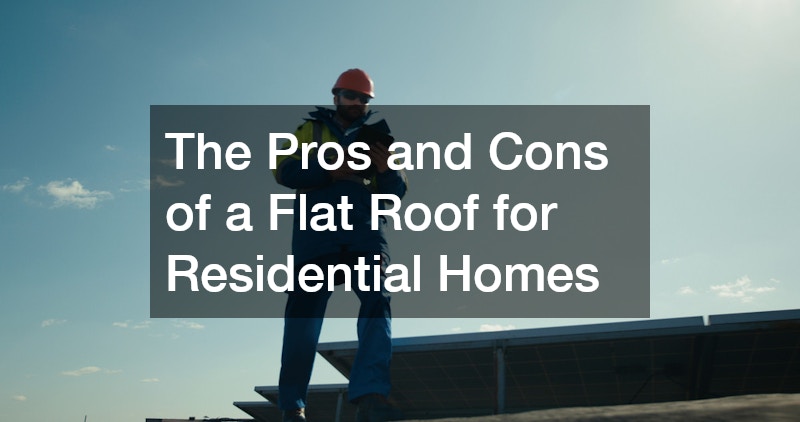
The Pros and Cons of a Flat Roof for Residential Homes
Explore the growing trend of flat roofs in residential architecture, examining their advantages and disadvantages to better understand their suitability for modern homes.
The Benefits Flat Roofs Offer for Residential Homes
Cost-Effectiveness
Flat roofs have become increasingly popular, largely due to their cost-effectiveness. Compared to sloped roofs, flat roofs require less material for construction, significantly reducing initial expenses.
Moreover, their simpler design tends to result in lower labor costs.
These types of roofs also typically incur lower maintenance costs. The materials used in flat roofing systems, such as modified bitumen, are generally less expensive and easier to repair. As a result, flat roofs may present a financially appealing option for budget-conscious homeowners.
However, it is crucial to factor in potential long-term expenses. In certain climates, additional investments might become necessary to address issues like drainage and insulation, which can affect the overall cost-benefit analysis. Therefore, while initially cost-effective, flat roofs may involve future financial considerations.
Space Utilization
One of the standout benefits of flat roofs is the potential for enhanced space utilization. Homeowners can transform these spaces into functional areas like rooftop gardens or lounges, allowing for outdoor leisure and enjoyment. Additionally, flat roofs offer an ideal platform for the installation of solar panels.
This additional space can add significant value to a residential property. In urban environments, where outdoor space is often limited, flat roofs provide much-needed room for various activities and installations. Consequently, flat roofs can significantly increase the functional square footage of a home.
The utilization of flat roof space must be carefully planned, particularly in terms of structural support. The weight of installations or possible gatherings requires thorough consideration and potentially an engineering assessment. Proper planning ensures the space can be enjoyed safely and effectively.
Potential Drawbacks of Having a Flat Roof
Drainage Issues
One of the primary drawbacks of flat roofs is the potential for drainage issues. Unlike their sloped counterparts, flat roofs do not naturally facilitate water runoff, leading to pooling. This can increase the likelihood of leaks if not properly managed.
Effective drainage systems are essential to prevent water accumulation. Solutions such as adding a slight pitch, installing appropriate drains, and maintaining them meticulously can mitigate such issues. However, these measures can add complexity and ongoing maintenance to the ownership experience.
Ignoring drainage problems can lead to significant water damage over time. Homeowners must be proactive about inspections, especially after heavy rainfalls. Ensuring the proper functioning of drainage systems is vital to maintaining the integrity of a flat roof.
Longevity and Maintenance
Flat roofs, while economical upfront, may have a shorter lifespan than sloped roofs. They typically last between 10 to 20 years, depending on material choices and weather exposure. Proper maintenance is critical to maximizing their longevity.
Regular inspections and repairs are essential to keep flat roofs in good condition. Debris should be regularly cleared to prevent moisture build-up and damage. Timely repairs of any wear or damage detected can prolong the life of the roof.
Nonetheless, the maintenance demands of flat roofs can be more intensive. Homeowners must weigh these ongoing efforts against the initial savings in construction and materials. Awareness of potential maintenance challenges helps ensure that flat roofs remain a viable roofing option.
Is a Flat Roof Suitable for All Climates?
Climate Considerations
The suitability of flat roofs varies significantly with climate considerations. In regions with heavy rainfall or snowfall, flat roofs may experience issues like water accumulation and weight stress. Proper drainage and reinforcement are necessary to address these concerns effectively.
In arid or temperate regions, flat roofs may face fewer climatic challenges. Here, the simpler design can thrive under conditions that require less frequent rainfall management. Understanding the local climate helps determine if a flat roof is the right choice.
Customization for climate needs is critical to the success of a flat roof. Homeowners should discuss climate-specific challenges with contractors to incorporate appropriate solutions. This ensures the roof can withstand local environmental conditions over time.
Thermal Performance
Flat roofs can present challenges in terms of thermal performance. In colder climates, their minimal slope can lead to heat loss, increasing the demand for heating systems. Adequate insulation is crucial to mitigate these effects and maintain energy efficiency.
In warmer climates, flat roofs can absorb more sunlight, potentially increasing cooling costs. Reflective coatings and strategic landscaping can reduce heat absorption and improve energy efficiency. Properly managing a flat roof’s thermal performance is essential for cost-effective energy consumption.
Ultimately, the impact of a flat roof on a home’s energy use hinges on effective insulation and material choice. Homeowners should plan for thermal management from the outset. Incorporating energy-saving features enhances the overall sustainability of flat roofs.
Flat roofs offer a mix of advantages and disadvantages, influenced heavily by individual needs and local climates. While they can be more economical and provide extra space, they demand attentive maintenance and may have higher upkeep in certain climates. Ultimately, weighing these factors is essential for homeowners considering flat roofs, enabling informed decisions about roofing that suits their specific circumstances.
